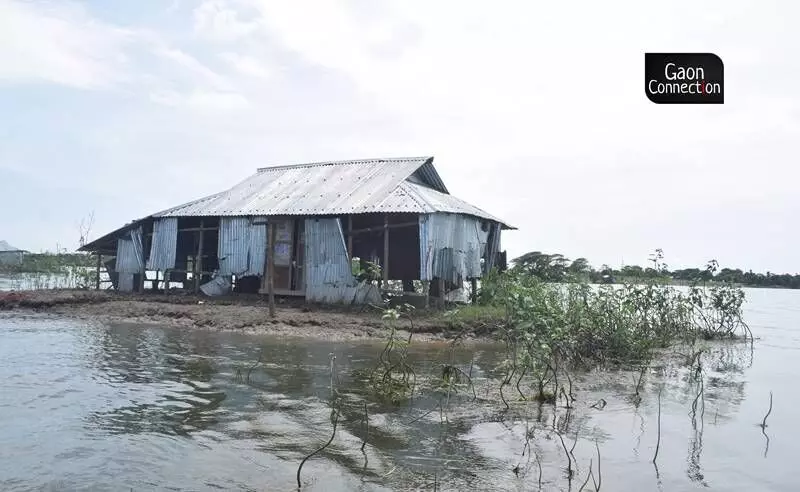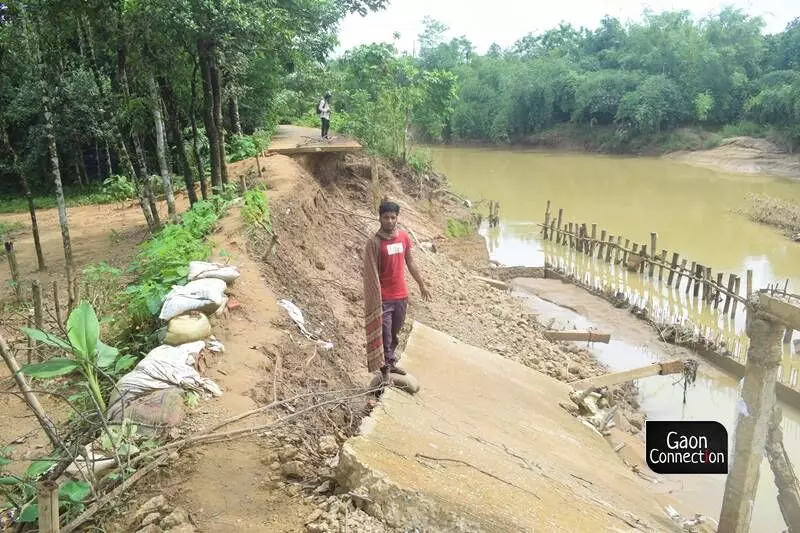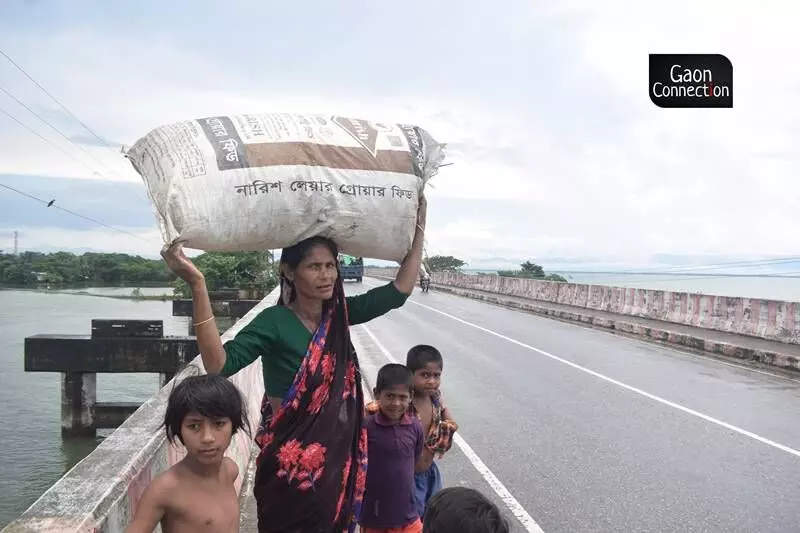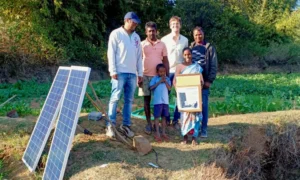Sylhet, Bangladesh
The floods have come and gone, but the crisis for the flood-affected in Bangladesh is far from over. Unemployment, displacement from their homes, rising debts, and the suspension of food aid has left a large part of the populace in Sylhet, in north-east Bangladesh, struggling to survive.
The home of Helal Uddin, an inhabitant of Noagaon village of South Sunamganj upazila was swept away by the flood waters in June this year. His family of nine has been living on the side of the highway ever since.
Helal Uddin said that he was trying to make ends meet by working as a driver, but the work was sporadic. “Only my family members survived. Everything else we owned was swept away. If I have to rebuild my home and live in it, I will need at least four lakh taka (1 Bangladesh taka = 0.83 Indian rupee). Where do I find that kind of money,” the 40-year-old asked in despair.
The northeastern region of Bangladesh was hit by heavy monsoon rains and flash floods. Millions were affected and hundreds of thousands hectares of farmland was inundated leading to heavy crop losses. According to sources in the administrative department of Sylhet, flood waters entered large parts of Sylhet district inundating 80 per cent of it, while 90 per cent of Sunamganj district was flooded.

The floods this year, which arrived earlier than usual, are a typical example of ‘loss and damage’, say climate experts.
The condition of the people in these two districts continues to be distressing. Bhadeshwar village in Golapganj upazila; Sonapur and Katalpur villages in Fenchuganj upazila and Hajiganj respectively; Dharampur village in South Sylhet upazila; Siddharchar village in Chhatak upazila; and Banglabazar and Alamkhali village in Doarbazar upazila are particularly bad. Many of the homeless villagers are still living in shacks along the highway.
Abdul Quddus and his family continue to take shelter on the Sylhet-Sunamganj highway near Manbeg village. “We came here when the floods drowned our home,” the 52-year-old told Gaon Connection. “I have taken a loan of 10,000 taka to deal with the flood crisis, and I am still struggling to support myself and my family,” he said.
The floods this year, which arrived earlier than usual, are a typical example of ‘loss and damage’, say climate experts. ‘Loss and damage’ is a general term used in the UN climate negotiations to refer to the consequences of climate change that go beyond what people can adapt to, or when options exist but a community doesn’t have the resources to access or utilise them. Loss and damage is and will continue to harm vulnerable communities the most, making addressing the issue a matter of climate justice.
While one region of the delta country is facing the aftermath of floods, another region is coping with drought and loss of kharif paddy sowing, which has registered a sharp decline due to deficient monsoon rainfall.

Bangladesh is amongst the top seven countries in the world that are most vulnerable to climate change.
Extensive damage and displacement
Siddharchar village in Chhatak upazila, Sunamganj district is still reeling from the aftermath of the floods. The village was home to about 120 families and it was completely submerged for over a week.
“I have never seen this kind of flooding in my life. I lost everything in the flood. The flash floods left us with no time to carry away anything from inside the house. We escaped with our lives,” Manfar Ali, a resident of Siddharchar village, told Gaon Connection. “When I came home after the flood waters receded, I found nothing left. I have to buy everything again,” the 65-year-old added.
The access road to Siddharchar village from the main road has been damaged by flood waters. The community clinic at the entrance of the village was also submerged and has not started functioning yet. The Ma-Moni Ideal Academy, a school where the children studied, is destroyed.
“The village is still very much in trouble. Some emergency food aid arrived here after the floods. But rehabilitation of the village people will need a lot more work and so far there has been no initiative to do so,” Shamim Ahmed, head teacher of Ma-Moni Ideal Academy, told Gaon Connection.
Omar Gani, a member of Ward No. 6 of Bogla Union Council of Dowarabazar upazila in Sunamganj district, said, “When the water in the river rises, we are afraid. Houses in the area were washed away by the flood water after breaking the river bank. Strong embankments should be built on the river banks. People affected by floods should be rehabilitated.”
Overwhelming expenses to both people and the exchequer
State Minister for Disaster Management and Relief, Enamur Rahman, in a press conference said that taka 86,811 crore of damage has been caused due to severe floods in 18 districts of north and north-eastern regions of Bangladesh.
According to the minister, more than 2.8 million people have been affected by the floods. About taka 1258.53 crore worth of crops were totally damaged and taka 55957.21 crore worth of crops were partially damaged due to the floods. The total and partial damage to houses were to the tune of taka 368.84 crore, and over taka 1,355.03 crore respectively, he said.
The government has allotted rice, dry food, baby food and animal feed, and eight thousand bundles of corrugated iron sheets for the flood victims.
“The people of this area have never seen such a flood before. I myself was affected. The government is trying its best to compensate for this loss. Initiatives have been taken to rehabilitate the affected families,” Mamunur Rahman, Chatak Upazila Nirbahi Officer of Sunamganj district, told Gaon Connection.
Climate migrants on the rise
Bangladesh is amongst the top seven countries in the world that are most vulnerable to climate change, according to the Global Climate Risk Index (CRI) 2021 published by Germanwatch, a Berlin-based non-profit environmental think tank.
The Sixth Assessment Report of the United Nations Intergovernmental Panel on Climate Change (IPCC) has predicted an increase in rainfall, cyclones, high tides and floods in the coming years in 11 countries of the world, of which Bangladesh is one.
In the Sylhet region people said that they have not seen such devastation in living memory. The last time such a situation was recorded was 122 years ago. This year, more than 7 million people have been affected by the Sylhet floods and nearly 500,000 people have lost their homes.
“The impact of climate change is excess rain and excess drought. This time, we have seen that due to excessive rainfall in Cherrapunji, India, there has been flooding in the northeastern Sylhet region of Bangladesh. Both climate change and man-made factors are behind this. Scientists have already given such indications,” said Atiq Rahman, executive director of the Bangladesh Center for Advanced Studies (BCAS), and co-recipient with Al Gore,of the Nobel Peace Prize in 2007.

While one region of the delta country is facing the aftermath of floods, another region is coping with drought and loss of kharif paddy sowing, which has registered a sharp decline due to deficient monsoon rainfall.
The number of displaced people in the country due to the climate crisis is increasing every year. According to the Global Report on Internal Displacement 2021 of the Switzerland-based organisation Internal Displacement Monitoring Centre, 4.4 million were displaced in Bangladesh in 2020.
In its groundswell report published last year in September 2021, the World Bank has expressed fears that 216 million people will be internally displaced in six regions of the world by 2050 if the necessary measures are not taken to prevent climate change. Forty million people will be displaced in the South Asian region, with 19.9 million people expected to be displaced in Bangladesh alone.
















